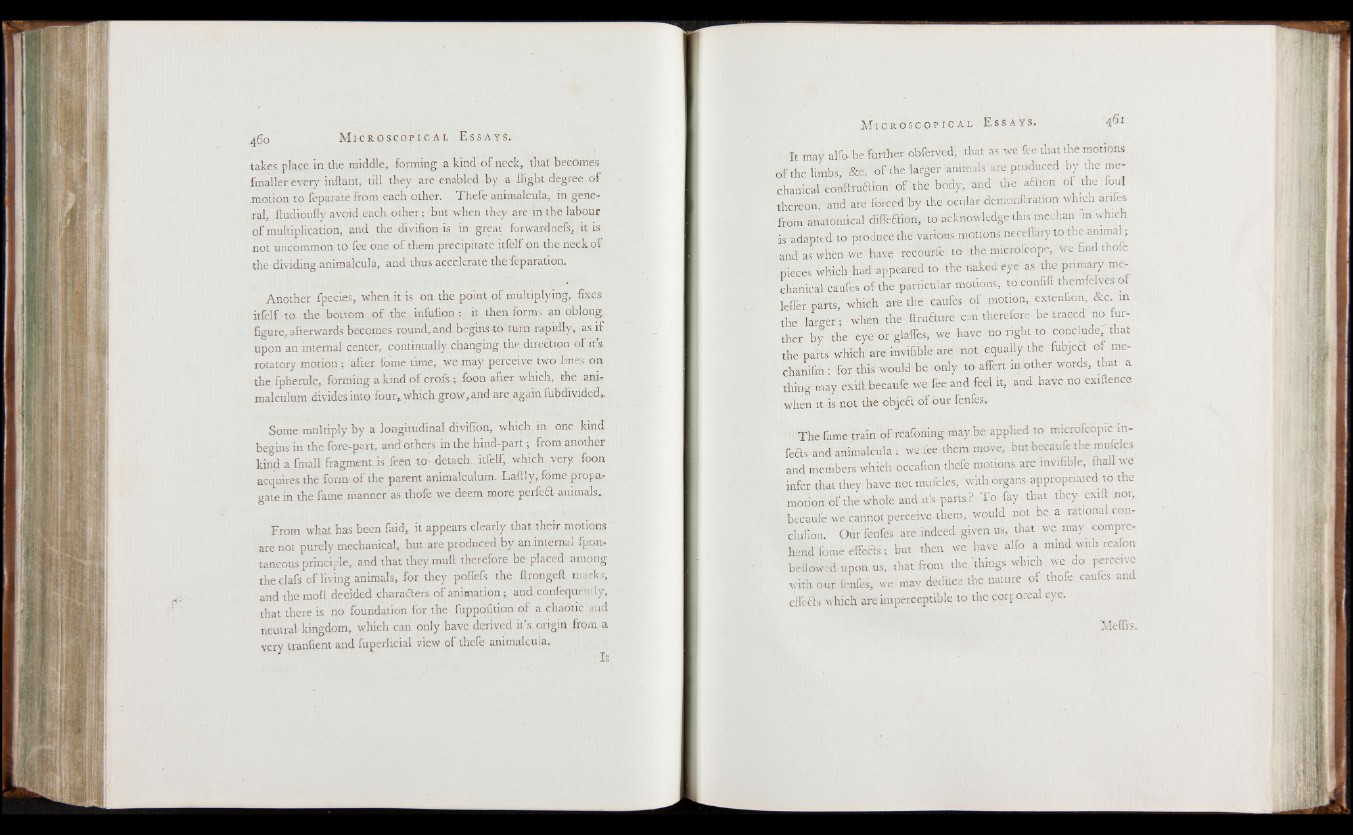
takes place in the middle, forming a kind of neck, that becomes
fmaller every inftant, till they are enabled by a flight degree o f
motion to feparate from each other. Thefe animalcula, in general,
ftudioufly avoid each other; but when they are in the labour
o f multiplication, and the divifton is in great forwardnefs, it is
not uncommon to fee one of them precipitate itfelf on the neck of
the dividing animalcula, and thus accelerate the feparation.
Another fpecies, when it is on the point o f multiplying, fixes:
itfelf to the bottom o f the infufion ; it then forms an oblong
figure, afterwards becomes round, and begins to turn rapidly, as if
upon an internal center, continually changing the direction of its
rotatory motion ; after fome time, we may perceive two lines on
the fpherule, forming a kind of erofs.; focrn after which, the ani-
malculum divides into four,, which grow, and are againfubdivided*.
Some multiply by a longitudinal divifion, which in one kind
begins in the fore-part, andothers in the hind-part; from another
kind a fmall fragment is feen to- detach itfelf, which very foon
acquires the form of the parent animalculum. Laftly, fome propagate
in the fame manner as thofe we deem more perfect ahimals.
From what has been faid, it appears clearly that their motions
are not purely mechanical, but are produced by an.internal fpon-
taneous principle, and that they mull therefore be placed among
the clafs of living animals, for they poflefs the ftrongeft marks,
and the molt decided characters of animation ; and confequently,
that there is no foundation for the fuppolition o f a chaotic and
neutral kingdom, which can only have derived it’s origin from a
very tranfient and fuperficial view of thefe animalcula.
It
It may alfobe further obferved, that as we fee that the motions
of the limbs, &c. o f the larger animals are produced by the mechanical
conltruction o f the body, and the a&on of the foul
thereon, and are forced by the ocular demonftration which arifes
from anatomical diffeffion, to acknowledge this median an which
is adapted to produce the various motions neceffary to the animal ;
and as when we have recourfe to the microfcope, we find thofe
pieces which had appeared to the naked eye as the primary mechanical
caufes of the particular motions, to conflit themfelves o f
leffer parts, whiph are the caufes o f motion, extenfion, &c. in
the larger; when the ftruaure can therefore be traced no further
by the eye or glaffes, we have no right to conclude, that
the parts which are invifible are not equally the fubjea of me-
chanifm : for this would be only to affert in other words, that a
thing may exiltbecaufe we fee and feel it, and have no exiftence
when it is not the objea of bur fenfes.
The fame train of reafoning may be applied to microfcopic m-
fea s and animalcula ; we fee them move, butbecaufe the mufcles
and members which occafion thefe motions are invifible, ihali we
infer that they have not mufcles, with organs appropriated to the
motion o f the whole and it’s parts ? T o fay that they exift not,
becaufe we cannot perceive them, would not be a rational conclufion.
Our fenfes are indeed given us, that we may comprehend
fome effeds ; but then we have alfo a mind with reafon
bellowed upon us, that from the'things which we do perceive
with our fenfes, we may deduce the nature of thofe caufes and
effeâs which are imperceptible to the corporeal eye.
Meffrs.